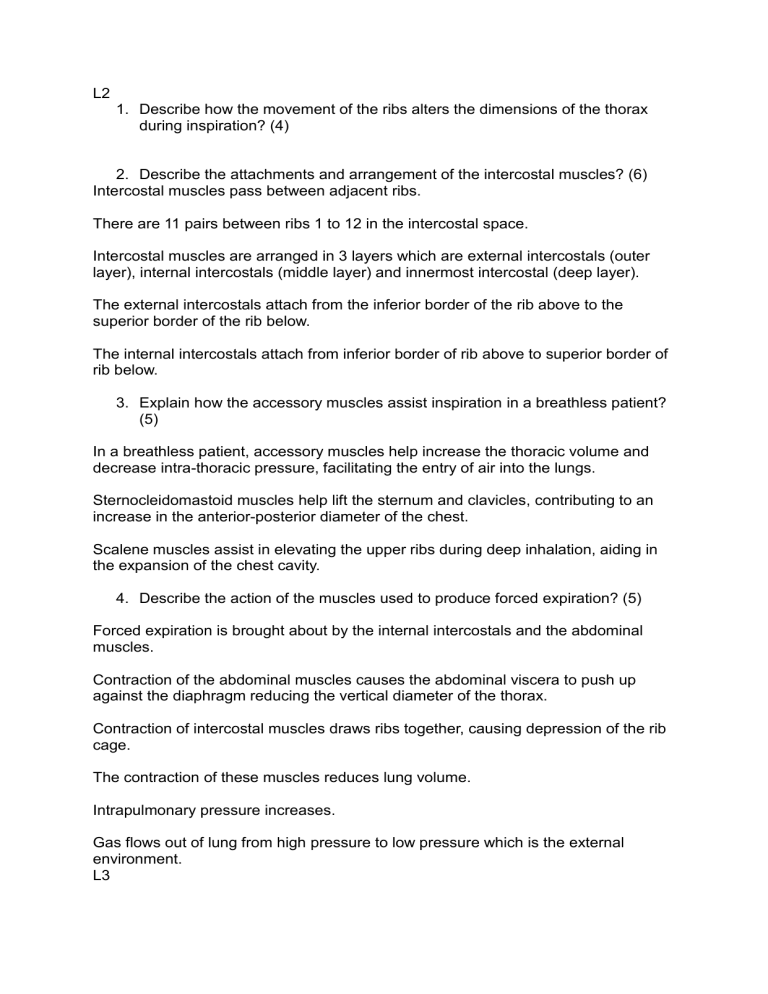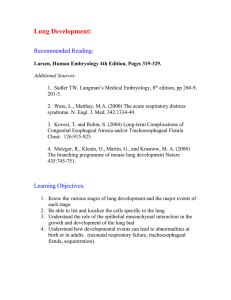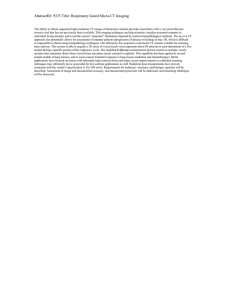
L2 1. Describe how the movement of the ribs alters the dimensions of the thorax during inspiration? (4) 2. Describe the attachments and arrangement of the intercostal muscles? (6) Intercostal muscles pass between adjacent ribs. There are 11 pairs between ribs 1 to 12 in the intercostal space. Intercostal muscles are arranged in 3 layers which are external intercostals (outer layer), internal intercostals (middle layer) and innermost intercostal (deep layer). The external intercostals attach from the inferior border of the rib above to the superior border of the rib below. The internal intercostals attach from inferior border of rib above to superior border of rib below. 3. Explain how the accessory muscles assist inspiration in a breathless patient? (5) In a breathless patient, accessory muscles help increase the thoracic volume and decrease intra-thoracic pressure, facilitating the entry of air into the lungs. Sternocleidomastoid muscles help lift the sternum and clavicles, contributing to an increase in the anterior-posterior diameter of the chest. Scalene muscles assist in elevating the upper ribs during deep inhalation, aiding in the expansion of the chest cavity. 4. Describe the action of the muscles used to produce forced expiration? (5) Forced expiration is brought about by the internal intercostals and the abdominal muscles. Contraction of the abdominal muscles causes the abdominal viscera to push up against the diaphragm reducing the vertical diameter of the thorax. Contraction of intercostal muscles draws ribs together, causing depression of the rib cage. The contraction of these muscles reduces lung volume. Intrapulmonary pressure increases. Gas flows out of lung from high pressure to low pressure which is the external environment. L3 1. List the defence mechanisms of the respiratory system, outlining how each contribute to maintain lung hygiene (10) Vibrissae in nostril helps filter out large particles, pollen and dust. Nasal turbinates contains mucus which possesses anti-bacteria enzyme to prevent pathogens enter the lungs. Epiglottis stops unwanted substances e.g. food to go to lungs. Nasal mucosal contains receptors which detect irritation to stimulate the nerve to trigger sneezing and coughing to stop irritants getting further down. 2. Describe the structure and function of the mucociliary transport system (10) Mucociliary transport system contains 3 components which are ciliated epithelial cells, aqueous (sol) layer and gel (sputum) layer. Cilia is microscopic hair like process extending from the surface of a cell. It is capable of rhythmic motion and act in unison with other cilia to cause movement of cell or surrounding medium. Respiratory tract ciliated epithelial cells help sweeping clean dust and germs trapped in mucus secreted by goblet cells. Aqueous layer is low resistance watery fluid which locates at the shaft of cilia. It facilitates ciliary movement. Gel layer locates on top of sol layer. It helps trap foreign particles and which can be coughed out of the lung. 3. Describe how functioning of the MCT system may be disturbed (10) If lung produces too much sputum, ciliary movement will decrease due to increase thickness of gel layer. Foreign particles trapped in sputum cannot be removed effectively as a result. If mucus is trapping in the lung, the lung environment becomes warm and wet which attracts bacteria, causing infection. Cold air reduce cilia beating frequency, therefore the nose will drip Primary ciliary dyskinesia affect the structure of cilia, causing the cilia to beat in opposite direction. Hence mucus cannot be cough out of lung. Anesthesia stops ciliary function temporary but the lung keep producing mucus, causing the mucus cannot be remove from lung effectively. Aging reduces ciliary beating frequency. Mucus cannot be removed effectively from lung. Infection will reduce the number of cilia as pathogens will attack ciliated epithelial cell, reducing the beating effectiveness of cilia. Smoking will stop cilia from beating and degenerated, causing retention of secretions. L4 1. A young man is admitted with a spontaneous pneumothorax, describe what you might expect to see on his CXR (3) Black shadow of lung Shift of internal structures No lung marking 2. Describe what you might expect to hear on chest auscultation (2) Decreased or absent breathing sound 3. What immediate medical intervention will be required for a large pneumothorax and describe how this will restore the lung mechanics (5) Intercostal drain inserted to restore negative intrapleural pressure. Excess air will flow out of the pleural space into the chest drain bottle and then lung will reinflate. L5 Nil L6 1. What signs of increased work of breathing might be seen whilst observing the breathless patient? (10) Increased use of accessory muscles e.g. scalene and SCM Pursed lip breathing Soft tissue recession Active expiration Prolong expiration 2. A patient is admitted with an acute exacerbation of bronchiectasis. Explain what questions should be asked in a subjective assessment regarding this patient’s symptoms? (10) Dyspnoea Do you feel breathless? When did it start? Is it getting better or worse? What make it worse? Does anything make the breathlessness better? Do you find any position makes your breathlessness better? Is your breathlessness worse at particular time? Reason: bronchiectasis can lead to difficult in breathing and exacerbation of bronchiectasis will make breathlessness severe. Cough Do you cough atm? Do you bring phlegm when you cough? Is it difficult to … Do you usually cough? When do you cough? What eases the cough? Have you been coughing up any blood? Reason: Patient with exacerbation of bronchiectasis may suffer from increased in sputum and infection could lead to hemoptysis which shows patient’s bronchiectasis has been worsened. Sputum What is the color of sputum? How much sputum do you cough in a day? Is your sputum thick or runny? Does the sputum have an unpleasant odour? anaerobic organism Reason: sputum color can show if there is infective exacerbation of bronchiectasis. There is infection if the sputum is mucopurulent or purulent. Wheeze Are you aware of any tightness in your chest when you are breathing? Is it worse when you breathe in or out? Does anything help? Does anything make it worse? Reason: acute exacerbation of bronchiectasis will lead to further tightness in breathing. Chest pain Type of pain? Location? Pain score? Ease? Aggravating factors and easing factors? Reason: acute exacerbation of bronchiectasis will lead to increased in chest pain L7 1. Describe the pathophysiology of pneumonia relating it to the presenting symptoms (10) Symptoms of infected pneumonia are caused by invasion of lungs by microorganisms and by immune system’s response to that infection. Organisms invade spaces between cells and between alveoli via connecting pores. The invasion cause inflammation of the pleura which leads to cough and chest pain as the sensory nerve is stimulated by inflammation. At the same time, inflammation also cause fever and rigors. In addition, haemoptysis occurs due to damage of capillaries caused by inflammation. The invasion of micro-organisms also triggers the immune system. Neutrophils engulf and kill organisms. WBCs activate chemical cytokines which stimulate blood vessel to dilate and allow fluid to leak into the alveoli. The presence of inflammatory cytokines reverses hypoxic pulmonary vasoconstriction (HPVC). Ventilation and perfusion mismatching occurs as a result which leads to rapid shallow breathing. Since there is fluid leaking into the alveoli due to the effect of cytokines, consolidation occurs which produce bronchial breath sounds transmission from trachea and main airways. Due to the accumulation of fluid in lung, breath sound over pneumonic area also reduces. Sputum production may also take places when consolidation is dissolved. Weight loss may also occur due to pneumonia. 2. Describe the criteria necessary for gas exchange (2.5) How may these be disrupted in pneumonia (7.5) Criteria necessary for gas exchange are concentration, gas solubility, thickness of alveolar membrane, surface area of alveolar membrane and coupling of ventilation and perfusion. Since there is no fresh inspired air reaching alveoli due to accumulation of fluid, alveolar partial pressure exerted is reduced. Hence, concentration to facilitate diffusion of gas is reduced, Due to pneumonia, small amount of O2 is dissolved in fluid. Given that O2 is poorly soluble, gas exchange is reduced. Presence of inflammatory fluid in interstitium and exudate in alveoli increase distance for diffusion. With disease progression alveolar membrane can become fibrotic and thickened. Hence, gas exchange is disrupted. Areas of consolidated lung blocked and unable to participate in gas exchange. Surface area of alveolar membrane is reduced which decreases the rate of gas exchange. Since pneumonic areas are consolidated and unventilated, Rate of ventilation decreases. However, presence of inflammatory cytokines reverses hypoxic pulmonary constriction which leads to continued perfusion. Continued perfusion of non-ventilated airspaces produces V/Q mismatch (Shunt). Hypoxaemia occurs as a result. 3. Describe the physiotherapy management for a patient with a consolidated right middle lobe pneumonia (10) High flow O2 therapy provides patients with warmed and humidified air. It generates back pressure to flushes dead space of the nasopharyngeal cavity allowing for better ventilation as well as oxygenation. Physios can also adjust patients’ positioning to maximized ventilation and perfusion. At the same time, physios can adopt airway clearance techniques if productive of sputum. Physio can also provide patients with ventilatory support, fluid resuscitation and analgesia for chest pain. L8 L9 1. Describe the role of the central chemoreceptors in the regulation of breathing (10) The roles of the central chemoreceptors are to control and modify ventilation on breath-by-breath basis, feedback input to respiratory control center to later intrinsic respiratory pattern and to maintain PaCO2 PaO2 and pH within physiological limits regardless of activity. When CO2 diffuses across blood brain barrier, CO2 combines with H2O in CSF and this form carbonic acid. Carbonic acid disassociates to form bicarbonate and hydrogen ions. pH of cerebrospinal fluid decreases due to increase concentration of H+ ions. Decrease in pH of cerebrospinal fluid simulates central chemoreceptors to feedback to respiratory control center which stimulate effectors to increase the rate and depth of ventilation until CO2/ pH levels back in normal range. Conversely when CO2 is low, rate and depth of ventilation is reduced to allow CO2 or pH to normalize. 2. Describe the role of the peripheral chemoreceptors in the regulation of breathing (10) The role of peripheral chemoreceptors is to sample surrounding arterial blood. It is sensitive to arterial hypoxemia. It also stimulates sympathetic activity, inhibit parasympathetic activity and increase arterial blood pressure. 3. Describe the physiological consequences of delivering high dose O2 therapy to a patient with COPD (10) Delivering high dose O2 therapy to a patient with COPD will elevate the level of PaCO2. Loss of hypoxic drive occurs as COPD patients with chronic hypercapnia rely on peripheral chemoreceptors to sense arterial hypoxemia. The only remaining drive to breathe is removed if patient given high dose O2 arterial hypoxaemia. Reversal hypoxic pulmonary vasoconstriction occurs. COPD patients have areas of lung destruction with poor ventilation with have hypoxia which leads to V/Q mismatch. Compensatory HVC occurs in those areas. If COPD patients given high dose O2 hypoxia in good lung tissue is reversed. Control centers also sensed so HPVC is also reversed, leading to perfusion of non-ventilated lung and increased V/Q mismatch. Haldane effect also occurs as haemoglobin has strong affinity for O2. O2 transported bound to Hb. When low O2 e.g. COPD CO2 binds to Hb. If give patient high dose O2 Hb brakes off from CO2 in preference to bind with O2. CO2 then dissolves in plasma, raising PaCO2. L10 L11 A patient with an acute exacerbation of chronic bronchitis is admitted to a medical ward ABG’s taken on air are described below pH 7.33 PCO2 6.8 PO2 6.8 HCO3- 30 BE +5 1. Explaining your answer, analyze the above arterial blood gas (3) pH is acidic because it is lower than 7.35 PCO2 is higher than normal as it exceeds 6 PO2 is lower than normal which shows the patient has hypoxaemia HCO3- is alkalotic as it is higher than 26 Change in HCO3- level is abnormal as it exceeds +2 2. Explain whether this patient is in respiratory failure (1.5) The patient has partially compensated respiratory acidosis with hypoxaemia as the pH is still acidic when HCO3- increased. This means it is partially compensated. PCO2 is also high which indicated that the patient has respiratory acidosis. Patient also has hypoxaemia as PO2 level is low. 3. With reference to the underlying pathophysiology of chronic bronchitis explain why the patient would present with this ABG profile (5.5) When patient has chronic bronchitis, repeated inhalation of pollutants leads to irritation of the airway mucosa. Hyperplasia and hypertrophy of mucus glands occurs in large airway. There are also hyperplasia of goblet cells at the expense of epithelial cilia and excessive amount of mucus in the airways. Ciliary function reduces and small airways become obstructed by mucus plug due to inflammation. Hence amount of air to the lung is reduced which leads to a reduction of gaseous exchange. PO2 level decreases. Due to constriction of airway, resistant to airflow increase and WOB also increases. There is V/Q mismatch. CO2 level therefore increases in blood which also make the blood acidic. Increase in acidity of blood stimulates the kidney to alter HCO3- to compensate lung dysfunction in order to maintain acid base balance. Therefore HCO3- level is high. L12 Respiratory Mechanics • What is innervated by the phrenic nerve? Parietal pleura and diaphragm • What factors generate pleural pressure? Tendency of the chest wall to expand Tendency of the lungs to recoil Compliance of the lung tissue Muscle activity of accessory muscle and intercostal muscle • Describe the process of quiet inspiration Respiratory muscles (diaphragm and external intercostal) contract Which leads to increase in thoracic and lung volume And decrease in intrapulmonary pressure Air flows into the lungs down the pressure gradient Airflow stops when intrapulmonary pressure is equal to atmospheric pressure • Describe the process of quiet expiration It is a passive process Inspiratory muscles relax Lung recoil Which leads reduced thoracic and lung volume And increased intrapulmonary pressures Gas flows out of the lung until intrapulmonary pressure is 0 • What happens to pleural pressure with a pneumothorax? 1. Loss of negative pressure as air enters the pleural cavity, and the negative pressure is compromised or lost. 2. Lung collapse as the introduction of air into the pleural cavity disrupts the balance between the elastic recoil of the lung and the chest wall. The lung may collapse or partially collapse (atelectasis) due to the loss of negative pressure. This can result in impaired lung function and reduced oxygen exchange. 3. Shift in mediastinum as the air accumulates in the pleural space, it can cause a shift in the mediastinum, the central part of the chest that contains the heart, major blood vessels, and other structures. This shift can further compromise cardiovascular function and lead to compression of vital structures. • What may you see on a CXR? No lung markings Mediastinal shift Lung Volumes & Ventilation • What is residual volume? The air cant expire and it remains in lung • What volumes make vital capacity? Inspiratory reserve volume (IRV) + Tidal volume (Vt) + Expiratory reserve volume (ERV) • What is minute ventilation? Volume of air entering lungs each minute • Name 2 types of dead space Anatomical dead space Alveolar dead space • Describe the abnormality in Shunt There is V/Q mismatch Capillary flow remains normal but ventilation decrease due to blockage of airway. • How does hypoventilation affect pH? Hypoventilation leads to poor CO2 exertion Partial pressure of CO2 in alveolus increases as CO2 cannot be breathe out effectively Partial pressure of CO2 in arterial blood also increases When CO2 increases, more carbonic acid is formed. Hence more H+ ions are formed due to dissociation of carbonic acid. Therefore pH decreases. Respiratory Assessment • Which respiratory symptoms would you ask about? Dysponea Cough Sputum Wheeze Chest pain • What will you ask about each one? Dysponea: onset, agg easing factors, severity and pattern Cough: time, ease, cough when eating, wet or dry Sputum: amount, colour, haemoptysis, viscosity, odour, Wheeze: tightness in chest, agg and ease Chest pain: type of pain, location, agg and ease, pain score • What is a wheeze? A wheeze is a high-pitched, musical or whistling sound that is produced when air flows through narrowed or constricted airways during breathing. • Name some causes of chest pain Lung cancer, ischaemic heart disease and fractured rib • Name 3 chest wall deformities Pectus excavatum (funnel chest), pectus carination and barrel chest • How may a breathless patient change their breathing pattern? Accessory muscles being used Soft tissue recession Prolonged expiration Active expiration Pursed lip breathing Gas Exchange • Name 5 criteria required for diffusion across the alveolar membrane • Define PaO2 and SaO2 • What is hypoxic pulmonary vasoconstriction? • What is the long term consequence of HVC? • What is the bronchiole response to CO2 • Describe pathophysiology of pneumonia Gas Transport • Describe the relationship between O2 and Hb • What affects Hb affinity for O2? • How is CO2 transported? • Analyse this ABG: pH 7.33 PCO2 6.7 PO2 10 HCO3- 28 BE +3 • Is this an acute or chronic problem? Control of Breathing • Name sensors which help regulate breathing • What is our main drive to breath? • Name the chemoreceptors • Describe how central chemoreceptors become desensitized to CO2 in a patient with chronic hypercapnia Airways Resistance • Describe the ANS innervation of the bronchial tree • What is Poiseuille’s Law? • What are the clinical consequences of increased resistance? • What factors contribute to increased resistance in Asthma? • What is remodelling? COPD • Define chronic bronchitis • Describe pathophysiology of emphysema • List clinical signs of COPD • What may you hear on auscultation? • What is hyperinflation? • Describe the different types of respiratory failure • Why should patients with COPD only have low flow O2?






